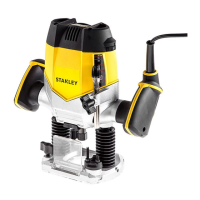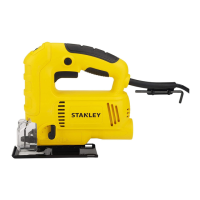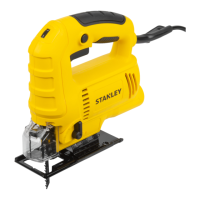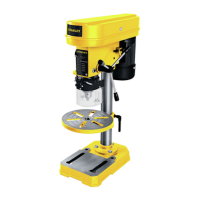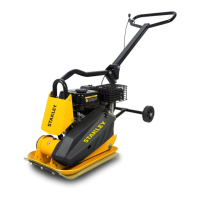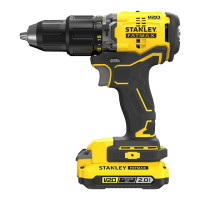ENGLISH • 19
f Select a piece of wood with a straight edge to use as
a batten.
f Place the batten onto the workpiece.
f Move the batten until it is in the correct position to
guide the tool.
f Securely clamp the batten to the workpiece.
USING THE TEMPLATE GUIDE (FIG. E)
(Template guide not included)
The template guide can be used to make a cutout shape
from a template, for instance a letter.
f Secure the template over the workpiece with
doublesided tape or ‘G’ clamps.
f The router bit must extend below the flange of the
template guide, to cut the workpiece in the shape of
the template.
USING THE DISTANCE PIECE (FIG. F)
(Distance piece not incldued)
The distance piece can be used for trimming wooden or
laminate vertical projections.
USING THE CENTRING PIN (FIG. G)
(Centring pin not included)
The centring pin can be used to cut out circular patterns.
f Drill a hole for the point of the centring pin in the
centre of the circle to be cut.
f Place the router on the workpiece with the point of the
centring pin in the drilled hole.
f Adjust the radius of the circle with the bars of the
edge guide.
f The router can now be moved over the workpiece to
cut out the circle.
USING THE COPY FOLLOWER (FIG. H)
(Copy follower not included)
The copy follower helps to maintain an equal cutting
distance along the edge of irregularly shaped workpieces.
f Place the router on the workpiece at the desired
distance from the edge to be copied.
f Adjust the bars of the edge guide until the wheel is in
contact with the workpiece.
SWITCHING ON AND OFF
The centring pin can be used to cut out circular patterns.
Switching on
f Keep the lock-off button (2) depressed and press the
on/off switch (1).
f Release the lock-off button.
Switching off
f Release the on/off switch.
Warning! Always operate the tool with both hands.
HINTS FOR OPTIMUM USE
f When working on outside edges, move the tool
counterclockwise (FIG. M). When working on inside
edges, move the tool clockwise.
f Use HSS router bits for softwood.
f Use TCT router bits for hardwood.
f You can use the tool without a guide (FIG. O). This
is useful for signwriting and creative work. Only make
shallow cuts.
f Refer to the table below for common types of
router bits.
ROUTER BITS (FIG. P)
DESCRIPTION APPLICATION
Straight bit (1) Grooves and rebates
Trimming bit (2)
Trimming laminates or
hardwood; accurate
profiling using a template
Rebating bit (3)
Rebates on straight or
curved workpieces
V-grooving bit (4)
Grooves, engraving and
edge bevelling
Core box bit (5)
Fluting, engraving and
decorative edge moulding
Cove bit (6) Decorative edge moulding
Ogee moulding bit (7) Decorative edge moulding
Rounding over bit (8) Rounding over edges
Dovetail bit (9) Dovetail joints
Chamfer bit (10) Chamfer edges
MAINTENANCE
Your tool has been designed to operate over a long period
of time with a minimum of maintenance. Continuous
satisfactory operation depends upon proper tool care and
regular cleaning.
Warning! Before performing any maintenance, switch
off and unplug the tool.
f Regularly clean the ventilation slots in your tool using
a soft brush or dry cloth.
f Regularly clean the motor housing using a damp
cloth. Do not use any abrasive or solvent-based
cleaner.
ACCESSORIES
The performance of your tool depends on the accessory
used. STANLEY accessories are engineered to
high quality standards and designed to enhance the
performance of your tool. By using these accessories you
will get the very best from your tool.
